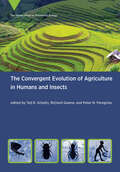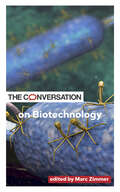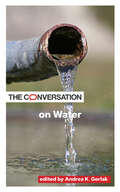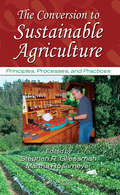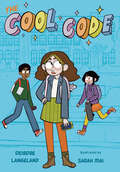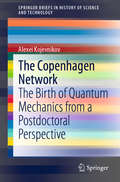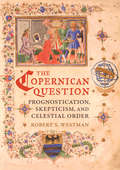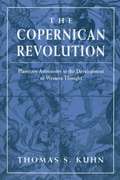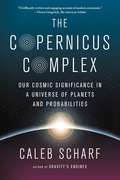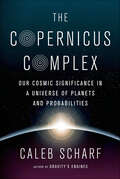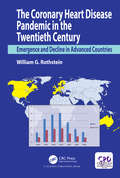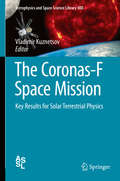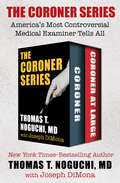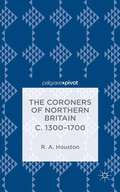- Table View
- List View
The Convergent Evolution of Agriculture in Humans and Insects (Vienna Series in Theoretical Biology)
by Ted R. Schultz, Richard Gawne, and Peter N. PeregrineContributors explore common elements in the evolutionary histories of both human and insect agriculture resulting from convergent evolution.During the past 12,000 years, agriculture originated in humans as many as twenty-three times, and during the past 65 million years, agriculture also originated in nonhuman animals at least twenty times and in insects at least fifteen times. It is much more likely that these independent origins represent similar solutions to the challenge of growing food than that they are due purely to chance. This volume seeks to identify common elements in the evolutionary histories of both human and insect agriculture that are the results of convergent evolution. The goal is to create a new, synthetic field that characterizes, quantifies, and empirically documents the evolutionary and ecological mechanisms that drive both human and nonhuman agriculture. The contributors report on the results of quantitative analyses comparing human and nonhuman agriculture; discuss evolutionary conflicts of interest between and among farmers and cultivars and how they interfere with efficiencies of agricultural symbiosis; describe in detail agriculture in termites, ambrosia beetles, and ants; and consider patterns of evolutionary convergence in different aspects of agriculture, comparing fungal parasites of ant agriculture with fungal parasites of human agriculture, analyzing the effects of agriculture on human anatomy, and tracing the similarities and differences between the evolution of agriculture in humans and in a single, relatively well-studied insect group, fungus-farming ants.
The Conversation on Biotechnology (Critical Conversations)
by Marc ZimmerFrom the contributors to The Conversation, this collection of essays by leading experts in biotechnology provides foundational knowledge on a range of topics, from CRISPR gene sequencing to the ethics of GMOs and "designer babies."In The Conversation on Biotechnology, editor Marc Zimmer collects essays from The Conversation U.S. by top scholars and experts in the field, who present a primer on the latest biotechnology research, the overwhelming possibilities it offers, and the risks of its abuse. From an overview of CRISPR technology and gene editing in GMOs to the ethical questions surrounding "designer babies" and other applications of biotechnology in humans, it highlights the major implications biotechnology will bring for health and society. Topics range from the spectacular use of light to fire individual neurons in the brain to making plant-based meats; from curbing diseases with genetically modified mosquitoes to looking back on 40 years of opinions on IVF babies.The Critical Conversations series collects essays from top scholars on timely topics, including water, biotechnology, gender diversity, gun culture, and more, originally published on the independent news site The Conversation U.S.Contributors: Nathan Ahlgren, Ivan Anishchenko, Trine Antonsen, Jennifer Barfield, Pedro Belda-Ferre, Ari Berkowitz, Adeline Boettcher, Jason Delbourne, Kevin Doxzen, Mo Ebrahimkhani, Eleanor Feingold, J. Benjamin Hurlbut, Cecile Janssens, Samira Kiani, Amanda Kowalczyk, Mariana Lamas, Andrew Lapworth, Rebecca Mackelprang, Kathleen Merrigan, Saman Naghieh, Sean Nee, Dimitri Perrin, Christopher Preston, Jason Rasgon, Penny Riggs, Jason Robert, Oliver Rogoyski, Gary Samore, Sahotra Sarkar, George E. Seidel, Patricia A. Stapleton, Craig W. Stevens, Paul B. Thompson, Christopher Tuggle, Vikramaditya G. Yadav, Marc Zimmer
The Conversation on Water (Critical Conversations)
by Andrea K. GerlakFrom the contributors to The Conversation, a compelling essay collection on the world's water crises and the necessary steps to build a more sustainable and equitable water future for all.Water-related crises are affecting more and more communities, both in the United States and internationally. If we continue to delay upgrading our infrastructure and addressing rising environmental concerns, we risk further destabilizing already strained systems—or, worse, causing a catastrophic collapse. In The Conversation on Water, water scholar and professor Andrea K. Gerlak collects essays from The Conversation U.S. on critical issues related to water from leading experts in everything from public policy to environmental engineering.Gerlak pays special attention to the threats facing our water systems today—covering insufficient infrastructure, climate change, and pollution—and integrates them with essays on technologies for harvesting water and Indigenous knowledge in governing the oceans. She then proposes solutions that present opportunities for hope and reform. From new partnerships and collaborative efforts to alternative governance practices and new scientific tools and community approaches, readers will learn about viable pathways forward and will understand the deep social and political dimensions of water governance. Understanding these challenges is the first step toward building a more sustainable and equitable water future for all. The Critical Conversations series collects essays from top scholars on timely topics, including water, biotechnology, gender diversity, gun culture, and more, originally published on the independent news site The Conversation U.S. Contributors: Roger Bales, Kevin Befus, Robert Blasiak, Ellen Bruno, Bethany Caruso, Sebastien Chastin, Craig E. Colten, Joseph Cook, Michelle DiBenedetto, Farshid Felfelani, Gabriel Filippelli, Michail Georgiou, Burke Griggs, Gary Griggs, Drew Gronewold, Marissa Grunes, Danielle Hare, Brian Haus, Dan Johnson, Carol Kwiatkowski, Rosalyn R. LaPier, Katharine Mach, Amahia Mallea, Daniel McCool, Jacob Miller-Klugesherz, Nobuhito Mori, Thomas Mortlock, Suzanne O'Connell, Itxaso Odériz, Joseph D. Ortiz, Meg Parsons, Raquel Partelli-Feltrin, Yadu Pokhrel, Manzoor Qadir, Julie Reimer, Landolf Rhode-Barbarigos, Richard Rood, Asher Rosinger, Matthew R. Sanderson, Heidi Schweizer, Alan Seltzer, A. R. Siders, Rodolfo Silva-Casarín, Vladimir Smakhtin, Bruce Sutherland, Lara Taylor, Emily Ury, Ton Van den Bremer, Andrew J. Whelton
The Conversion to Sustainable Agriculture: Principles, Processes, and Practices (Advances in Agroecology)
by Stephen R. Gliessman Martha RosemeyerWith all of the environmental and social problems confronting our food systems today, it is apparent that none of the strategies we have relied on in the pasthigher-yielding varieties, increased irrigation, inorganic fertilizers, pest damage reductioncan be counted on to come to the rescue. In fact, these solutions are now part of the problem. It i
The Cool Code (The Cool Code #1)
by Deirdre LangelandIn this funny and heartfelt slice-of-life graphic novel for fans of Raina Telgemeier and Kayla Miller, when coding whiz Zoey goes from homeschooled to new school, she develops an app to help her make friends. Will the Cool Code help Zoey fit in? Or will it completely crash her social life?In an attempt to fit in, Zoey develops an app called the Cool Code with a cute llama avatar that will tell her everything from what to say to what to wear based on pop culture algorithms she’s uploaded.But when the app gives her ridiculous advice, awkwardness and hilarity ensues. With a few upgrades and a bit of debugging from the coding club, the app actually works—Zoey gets really popular . . . and gets her pulled in all kinds of directions, including away from her real friends.Life’s most complicated choices. . . is there a code for that?
The Cooling
by Lowell PonteAre we entering a new ice age? Many scientists think so. Many others say that the climate is becoming unstable, and that this instability is a critical threat to world food production. Earth's climate has been cooling rapidly for the past three decades, and this has already caused drought and famine in major areas of the world. In the time it takes you to read this book, at least a thousand people will have starved to death because of the impact climatic instability already has had on food production. And The Cooling has barely begun. Few questions are as urgent today as those concerning climate change and what may be done about it. Dr. Cesare Emiliani, a "paleoclimatologist" at the University of Miami, says: "Is Earth's climate changing? Should governments try to modify climate? In dealing with these controversial issues, Lowell Ponte has written a remarkably thorough, far-ranging, balanced, and scientifically accurate book-the best popular book I have read on both these questions. I recommend THE COOLING to anyone who likes to think, and who cares about the planet we share."
The Copenhagen Network: The Birth of Quantum Mechanics from a Postdoctoral Perspective (SpringerBriefs in History of Science and Technology)
by Alexei KojevnikovThis book is a historical analysis of the quantum mechanical revolution and the emergence of a new discipline from the perspective, not of a professor, but of a recent or actual Ph.D. student just embarking on an uncertain academic career in economically hard times. Quantum mechanics exploded on to the intellectual scene between 1925 and 1927, with more than 200 publications across the world, the majority of them authored by young scientists under the age of 30, graduate students or postdoctoral fellows. The resulting theory was a collective product that no single authority could claim, but it had a major geographical nod – the Copenhagen Institute of Theoretical Physics – where most of the informal, pre-published exchange of ideas occurred and where every participant of the new community aspired to visit. A rare combination of circumstances and resources – political, diplomatic, financial, and intellectual – allowed Niels Bohr to establish this “Mecca” of quantum theory outside of traditional and more powerful centres of science. Transitory international postdoctoral fellows, rather than established professors, developed a culture of research that became the source of major innovations in the field. Temporary assistantships, postdoctoral positions, and their equivalents were the chief mode of existence for young academics during the period of economic crisis and post-WWI international tensions. Insecure career trajectories and unpredictable moves through non-stable temporary positions contributed to their general outlook and interpretations of the emerging theory of quantum mechanics. This book is part of a four-volume collection addressing the beginnings of quantum physics research at the major European centres of Göttingen, Copenhagen, Berlin, and Munich; these works emerged from an expansive study on the quantum revolution as a major transformation of physical knowledge undertaken by the Max Planck Institute for the History of Science and the Fritz Haber Institute (2006–2012).
The Copernican Question: Prognostication, Skepticism, and Celestial Order
by Robert S. WestmanIn 1543, Nicolaus Copernicus publicly defended his hypothesis that the earth is a planet and the sun a body resting near the center of a finite universe. But why did Copernicus make this bold proposal? And why did it matter? The Copernican Question reframes this pivotal moment in the history of science, centering the story on a conflict over the credibility of astrology that erupted in Italy just as Copernicus arrived in 1496. Copernicus engendered enormous resistance when he sought to protect astrology by reconstituting its astronomical foundations. Robert S. Westman shows that efforts to answer the astrological skeptics became a crucial unifying theme of the early modern scientific movement. His interpretation of this "long sixteenth century," from the 1490s to the 1610s, offers a new framework for understanding the great transformations in natural philosophy in the century that followed.
The Copernican Revolution: Planetary Astronomy In The Development Of Western Thought
by Thomas KuhnThe Copernican Revolution: Planetary Astronomy In The Development Of Western Thought
The Copernican Revolution: Planetary Astronomy in the Development of Western Thought
by Thomas S. KuhnFor scientist and layman alike this book provides vivid evidence that the Copernican Revolution has by no means lost its significance today. Few episodes in the development of scientific theory show so clearly how the solution to a highly technical problem can alter our basic thought processes and attitudes. Understanding the processes which underlay the Revolution gives us a perspective, in this scientific age, from which to evaluate our own beliefs more intelligently. With a constant keen awareness of the inseparable mixture of its technical, philosophical, and humanistic elements, Thomas S. Kuhn displays the full scope of the Copernican Revolution as simultaneously an episode in the internal development of astronomy, a critical turning point in the evolution of scientific thought, and a crisis in Western man s concept of his relation to the universe and to God. The book begins with a description of the first scientific cosmology developed by the Greeks. Mr. Kuhn thus prepares the way for a continuing analysis of the relation between theory and observation and belief. He describes the many functions astronomical, scientific, and nonscientific of the Greek concept of the universe, concentrating especially on the religious implications. He then treats the intellectual, social, and economic developments which nurtured Copernicus break with traditional astronomy. Although many of these developments, including scholastic criticism of Aristotle s theory of motion and the Renaissance revival of Neoplatonism, lie entirely outside of astronomy, they increased the flexibility of the astronomer s imagination. That new flexibility is apparent in the work of Copernicus, whose De Revolutionibus Orbium Coelestium (On the Revolutions of the Heavenly Spheres) is discussed in detail both for its own significance and as a representative scientific innovation. With a final analysis of Copernicus life work its reception and its contribution to a new scientific concept of the universe Mr. Kuhn illuminates both the researches that finally made the heliocentric arrangement work, and the achievements in physics and metaphysics that made the planetary earth an integral part of Newtonian science. These are the developments that once again provided man with a coherent and self-consistent conception of the universe and of his own place in it. This is a book for any reader interested in the evolution of ideas and, in particular, in the curious interplay of hypothesis and experiment which is the essence of modern science. Says James Bryant Conant in his Foreword: Professor Kuhn s handling of the subject merits attention, for he points the way to the road which must be followed if science is to be assimilated into the culture of our times.
The Copernicus Complex: Our Cosmic Significance in a Universe of Planets and Probabilities
by Caleb ScharfNicolaus Copernicus dared to go against the establishment by proposing that Earth rotates around the Sun. Having demoted Earth from its unique position in the cosmos to one of mediocrity, Copernicus set in motion a revolution in scientific thought. <P><P>This perspective has influenced our thinking for centuries. However, recent evidence challenges the Copernican Principle, hinting that we do in fact live in a special place, at a special time, as the product of a chain of unlikely events. But can we be significant if the Sun is still just one of a billion trillion stars in the observable universe? <P><P>And what if our universe is just one of a multitude of others-a single slice of an infinity of parallel realities? In The Copernicus Complex, the renowned astrophysicist Caleb Scharf takes us on a scientific adventure, from tiny microbes within the Earth to distant exoplanets, probability theory, and beyond, arguing that there is a solution to this contradiction, a third way of viewing our place in the cosmos, if we weigh the evidence properly. <P><P>As Scharf explains, we do occupy an unusual time in a 14-billion-year-old universe, in a somewhat unusual type of solar system surrounded by an ocean of unimaginable planetary diversity: hot Jupiters with orbits of less than a day, planet-size rocks spinning around dead stars, and a wealth of alien super-Earths. Yet life here is built from the most common chemistry in the universe, and we are a snapshot taken from billions of years of biological evolution. <P><P>Bringing us to the cutting edge of scientific discovery, Scharf shows how the answers to fundamental questions of existence will come from embracing the peculiarity of our circumstance without denying the Copernican vision. <P><P> With characteristic verve, Scharf uses the latest scientific findings to reconsider where we stand in the balance between cosmic significance and mediocrity, order and chaos. <P><P> Presenting a compelling and bold view of our true status,The Copernicus Complex proposes a way forward in the ultimate quest: determining life's abundance, not just across this universe but across all realities.
The Copernicus Complex: Our Cosmic Significance in a Universe of Planets and Probabilities
by Caleb ScharfLonglisted for the 2015 PEN/E.O. Wilson Literary Science Writing AwardShort-listed for Physics World's Book of the YearThe Sunday Times (UK) Best Science Book of 2014A Publishers Weekly Top 10 Science Book of Fall 2014An NBC News Top Science and Tech Book of 2014A Politics & Prose 2014 Staff PickIn the sixteenth century, Nicolaus Copernicus dared to go against the establishment by proposing that Earth rotates around the Sun. Having demoted Earth from its unique position in the cosmos to one of mediocrity, Copernicus set in motion a revolution in scientific thought. This perspective has influenced our thinking for centuries. However, recent evidence challenges the Copernican Principle, hinting that we do in fact live in a special place, at a special time, as the product of a chain of unlikely events. But can we be significant if the Sun is still just one of a billion trillion stars in the observable universe? And what if our universe is just one of a multitude of others-a single slice of an infinity of parallel realities?In The Copernicus Complex, the renowned astrophysicist Caleb Scharf takes us on a scientific adventure, from tiny microbes within the Earth to distant exoplanets, probability theory, and beyond, arguing that there is a solution to this contradiction, a third way of viewing our place in the cosmos, if we weigh the evidence properly. As Scharf explains, we do occupy an unusual time in a 14-billion-year-old universe, in a somewhat unusual type of solar system surrounded by an ocean of unimaginable planetary diversity: hot Jupiters with orbits of less than a day, planet-size rocks spinning around dead stars, and a wealth of alien super-Earths. Yet life here is built from the most common chemistry in the universe, and we are a snapshot taken from billions of years of biological evolution. Bringing us to the cutting edge of scientific discovery, Scharf shows how the answers to fundamental questions of existence will come from embracing the peculiarity of our circumstance without denying the Copernican vision.With characteristic verve, Scharf uses the latest scientific findings to reconsider where we stand in the balance between cosmic significance and mediocrity, order and chaos. Presenting a compelling and bold view of our true status, The Copernicus Complex proposes a way forward in the ultimate quest: determining life's abundance, not just across this universe but across all realities.
The Coronary Heart Disease Pandemic in the Twentieth Century: Emergence and Decline in Advanced Countries
by William G. RothsteinThis book demonstrates that a pandemic of coronary heart disease occurred in North America, western and northern Europe, and Australia and New Zealand from the 1930s to about 2000. At its peak it caused more deaths than any other disease. The book examines and compares trends in coronary heart disease mortality rates for individual countries. The most detailed analyses are for the United States, where mortality rates are examined for race, sex, and age groups and for geographic regions. Popular explanations for the rise and fall of coronary heart disease mortality rates are examined.
The Coronas-F Space Mission
by Vladimir KuznetsovThis volume is the updated and extended translation of the Russian original. It presents the results of observations of solar activity and its effects in the Earth space environment carried out from July 2001 to December 2005 on board the CORONAS-F space mission. The general characteristics of the CORONAS-F scientific payload are provided with a description of the principal experiments. The main results focus on the global oscillations of the Sun (p-modes), solar corona, solar flares, solar cosmic rays, Earth's radiation belts, and upper atmosphere. The book will be welcomed by students, post-graduates, and scientists working in the field of solar and solar-terrestrial physics. This English edition is supplemented by sections presenting new results of the SPIRIT and TESIS experiments under the CORONAS solar program, as well as from the SONG experiment onboard the CORONAS-F satellite.
The Coroner Series: America's Most Controversial Medical Examiner Tells All (Coroner)
by Thomas T. Noguchi Joseph DiMonaA New York Times–bestselling author and renowned Los Angeles medical examiner challenges the verdicts in America&’s most controversial celebrity deaths. &“Dr. Thomas T. Noguchi encountered the best and the worst of Los Angeles—movie stars and gangsters, politicians and millionaires. . . . But by the time &‘the coroner to the stars&’ met them, they were on his autopsy table&” (Los Angeles Times). In his New York Times–bestselling autobiography and its fascinating follow-up—now together in a single volume—Dr. Noguchi recounts his stormy career, divulges his innovative techniques, and reveals the full story behind his most intriguing investigations. Coroner: Dr. Noguchi sheds light on his most controversial cases: the suspicious drowning death of Natalie Wood, Marilyn Monroe&’s suicide, the assassination of Robert Kennedy, the circumstances behind the drug-related deaths of Janis Joplin and John Belushi, the murder of Sharon Tate. and more. Coroner at Large: Often called the &“Detective of Death,&” Dr. Noguchi continues to probe the most famous fatalities in recent pop-culture history: the drowning of Beach Boy Dennis Wilson, the Hollywood murder of Sal Mineo, the suicide of Freddie Prinze, the slaying of &“Playmate of the Year&” Dorothy Stratten, Elvis Presley&’s final hours, and more. Noguchi&’s forensic acumen also provides new clues to the fates of such historical figures as Gen. George Custer, Napoleon, and Adolf Hitler. In both riveting accounts, Dr. Noguchi documents his own investigations and pioneering work in the field, as the mysteries of death—natural and unnatural—are unraveled by &“one of the greats of modern forensic pathology&” (Barry A. J. Fisher, director of the Los Angeles County sheriff&’s crime lab).
The Coroners of Northern Britain c. 1300–1700
by R. A. HoustonFor the last 800 years coroners have been important in England's legal and political landscape, best known as investigators of sudden, suspicious, or unexplained death. Against the background of the coroner's role in historic England, this book explains how sudden death was investigated by magistrates in Scotland.
The Correspondence Of Charles Darwin: Volume 20 1872
by Janet Browne Frederick Burkhardt James A. Secord Samantha Evans Shelley Innes Francis Neary Alison M. Pearn Anne Secord Paul WhiteThis volume is part of the definitive edition of letters written by and to Charles Darwin, the most celebrated naturalist of the nineteenth century. Notes and appendixes put these fascinating and wide-ranging letters in context, making the letters accessible to both scholars and general readers. Darwin depended on correspondence to collect data from all over the world, and to discuss his emerging ideas with scientific colleagues, many of whom he never met in person. The letters are published chronologically: volume 20 includes letters from 1872, the year in which The expression of the emotions in man and animals was published, making ground-breaking use of photography. Also in this year, the sixth and final edition of On the origin of species was published, and Darwin resumed his work on carnivorous plants and plant movement, finding unexpected similarities between the plant and animal kingdoms.
The Correspondence of Charles Darwin
by Frederick Burkhardt James A. SecordOver 850 letters between Darwin and worldwide correspondents, as he gathered information on human origins and the expression of emotion.
The Correspondence of Charles Darwin 1877: VOLUME 25 (The Correspondence of Charles Darwin)
by Frederick Burkhardt James A. SecordThis volume is part of the definitive edition of letters written by and to Charles Darwin, the most celebrated naturalist of the nineteenth century. Notes and appendixes put these fascinating and wide-ranging letters in context, making the letters accessible to both scholars and general readers. Darwin depended on correspondence to collect data from all over the world, and to discuss his emerging ideas with scientific colleagues, many of whom he never met in person. The letters are published chronologically: volume 25 includes letters from 1877, the year in which Darwin published Forms of Flowers and with his son Francis carried out experiments on plant movement and bloom on plants. Darwin was awarded an honorary LL. D. by Cambridge University, and appeared in person to receive it. The volume contains a number of appendixes, including two on the albums of photograph sent to Darwin by his Dutch, German, and Austrian admirers.
The Correspondence of Charles Darwin: VOLUME 24
by Frederick Burkhardt James A. SecordThis volume is part of the definitive edition of letters written by and to Charles Darwin, the most celebrated naturalist of the nineteenth century. Notes and appendixes put these fascinating and wide-ranging letters in context, making the letters accessible to both scholars and general readers. Darwin depended on correspondence to collect data from all over the world, and to discuss his emerging ideas with scientific colleagues, many of whom he never met in person. The letters are published chronologically: volume 24 includes letters from 1876, the year in which Darwin published Cross and Self Fertilisation in the Vegetable Kingdom, and started writing Forms of Flowers. In 1876, Darwin's daughter-in-law, Amy, died shortly after giving birth to a son, Bernard Darwin, an event that devastated the family. The volume includes a supplement of 182 letters from earlier years, including a newly discovered collection of letters from William Darwin, Darwin's eldest son.
The Correspondence of Charles Darwin: Volume 26, 1878 (The Correspondence of Charles Darwin)
by Charles Darwin Frederick Burkhardt James A. Secord The Editors of the Darwin Correspondence ProjectThis volume is part of the definitive edition of letters written by and to Charles Darwin, the most celebrated naturalist of the nineteenth century. Notes and appendixes put these fascinating and wide-ranging letters in context, making the letters accessible to both scholars and general readers. Darwin depended on correspondence to collect data from all over the world, and to discuss his emerging ideas with scientific colleagues, many of whom he never met in person. The letters are published chronologically: volume 26 includes letters from 1878, the year in which Darwin with his son Francis carried out experiments on plant movement and bloom on plants. Francis spent the summer at a botanical research institute in Germany; and father and son exchanged many detailed letters about his work. Meanwhile, Darwin tried to secure government support for attempts by one of his Irish correspondents to breed a blight-resistant potato.
The Correspondence of Charles Darwin: Volume 27, 1879 (The Correspondence of Charles Darwin)
by Charles DarwinThis volume is part of the definitive edition of letters written by and to Charles Darwin, the most celebrated naturalist of the nineteenth century. Notes and appendixes put these fascinating and wide-ranging letters in context, making the letters accessible to both scholars and general readers. Darwin depended on correspondence to collect data from all over the world, and to discuss his emerging ideas with scientific colleagues, many of whom he never met in person. The letters are published chronologically: volume 27 includes letters from 1879, the year in which Darwin completed his manuscript on movement in plants. He also researched and published a biography of his grandfather Erasmus. The Darwins spent most of August on holiday in the Lake District. In October, Darwin's youngest son, Horace, became officially engaged to Ida Farrer, after some initial resistance from her father, who, although an admirer of Charles Darwin, thought Horace a poor prospect for his daughter.
The Correspondence of Charles Darwin: Volume 28, 1880 (The Correspondence of Charles Darwin)
by Charles Darwin The Editors of the Darwin Correspondence ProjectThis volume is part of the definitive edition of letters written by and to Charles Darwin, the most celebrated naturalist of the nineteenth century. Notes and appendixes put these fascinating and wide-ranging letters in context, making the letters accessible to both scholars and general readers. Darwin depended on correspondence to collect data from all over the world, and to discuss his emerging ideas with scientific colleagues, many of whom he never met in person. The letters are published chronologically. In 1880, Darwin published On The Power of Movement in Plants, and began writing his final book, The Formation of Vegetable Mould through the Action of Worms. He was engaged in controversy with Samuel Butler, following publication of his last book, Erasmus Darwin. At the end of the year, he succeeded in raising support for a Civil List pension for Alfred Russel Wallace, co-discoverer of the theory of natural selection.
The Correspondence of Charles Darwin: Volume 29, 1881 (The Correspondence of Charles Darwin)
by Charles DarwinThis volume is part of the definitive edition of letters written by and to Charles Darwin, the most celebrated naturalist of the nineteenth century. Notes and appendixes put these fascinating and wide-ranging letters in context, making the letters accessible to both scholars and general readers. Darwin depended on correspondence to collect data from all over the world, and to discuss his emerging ideas with scientific colleagues, many of whom he never met in person. The letters are published chronologically. In 1881, Darwin published his final book, The Formation of Vegetable Mould through the Action of Worms. He reflected on reactions to his previous book, The Power of Movement in Plants, and worked on two papers for the Linnean Society on the action of carbonate of ammonia on plants. In this year, Darwin's elder brother, Erasmus, died, and a second grandchild, also named Erasmus, was born.
The Correspondence of Charles Darwin: Volume 30, 1882 (The Correspondence of Charles Darwin)
by Charles DarwinThis volume is part of the definitive edition of letters written by and to Charles Darwin, the most celebrated naturalist of the nineteenth century. Notes and appendixes put these fascinating and wide-ranging letters in context, making the letters accessible to both scholars and general readers. Darwin depended on correspondence to collect data from all over the world, and to discuss his emerging ideas with scientific colleagues, many of whom he never met in person. The letters are published chronologically. Darwin died in April 1882, but was active in science almost up until the end, raising new research questions and responding to letters about his last book, on earthworms. The volume also contains a supplement of nearly 400 letters written between 1831 and 1880, many of which have never been published before.
